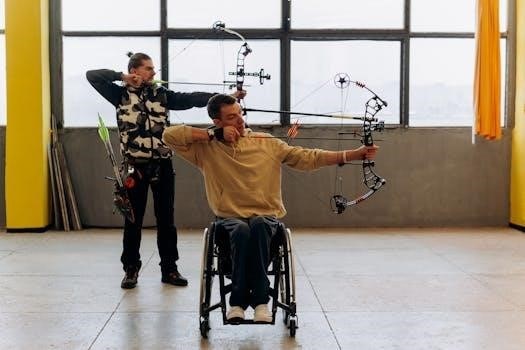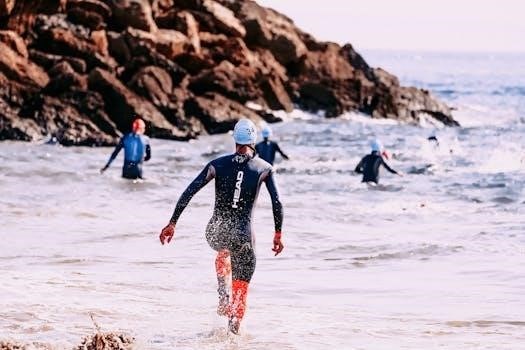
16 Week Olympic Triathlon Training Plan Overview
This 16-week plan is designed to prepare athletes for an Olympic distance triathlon‚ encompassing swim‚ bike‚ and run. It features structured phases‚ including base‚ build‚ and peak‚ with recovery weeks integrated. The plan aims to balance training load and prevent overtraining‚ suitable for both beginners and intermediate athletes.
Target Audience for the Plan
This 16-week Olympic triathlon training plan is primarily designed for individuals who have some existing fitness base and are looking to complete an Olympic distance triathlon. It caters to both beginner triathletes who are familiar with the three disciplines‚ and intermediate athletes who have perhaps completed a sprint distance triathlon and are now looking to step up to the longer Olympic distance. The plan is also suitable for those who have a recent background in fitness or sport. It assumes that the athlete can dedicate between 4-8 hours per week to training with 6 sessions a week‚ and some familiarity with swimming‚ cycling and running. This plan is not designed for absolute beginners with no fitness background‚ or for advanced athletes looking for a more customized plan. The goal is to help athletes build their fitness in each discipline and finish an Olympic distance triathlon within the 16-week timeframe.
Plan Duration and Structure
This 16-week Olympic triathlon training plan is structured into distinct phases to optimize performance and prevent overtraining. It is specifically designed to prepare athletes for a standard Olympic distance triathlon‚ consisting of a 1500m swim‚ 40km bike‚ and 10km run. The plan begins with a six week base phase‚ where the focus is on building a solid endurance foundation. This is followed by a five week build phase‚ where training intensity and volume are gradually increased. Finally‚ a five week peak phase which includes more specific race preparation. The plan also incorporates recovery weeks at weeks 4‚ 8‚ and 12. The final week is a taper week‚ reducing training load to ensure athletes are fresh for the race. The plan includes 6 workouts per week‚ typically consisting of 2 swim‚ 2 bike and 2 run sessions‚ fitting into a 4-8 hour weekly training schedule.

Phases of the 16 Week Training Plan
The 16-week plan is divided into three main phases⁚ a six-week base phase‚ a five-week build phase‚ and a five-week peak phase. These phases progressively increase training intensity and volume.
Base Phase (6 Weeks)
The base phase‚ lasting six weeks‚ focuses on building a solid aerobic foundation. This involves consistent‚ lower-intensity workouts across swimming‚ biking‚ and running. The goal is to improve endurance and overall fitness levels‚ preparing the body for more intense training. During this phase‚ emphasis is placed on developing proper technique and establishing a routine. Workouts are typically longer in duration but at a lower effort‚ promoting fat burning and cardiovascular adaptation. This is the time to focus on building a consistent training habit and ensuring you’re comfortable with the distances involved in an Olympic triathlon. It is crucial to listen to your body and avoid pushing too hard‚ allowing your body to adapt gradually. There will be a focus on building volume before intensity in this phase. This phase is important for injury prevention and building a base for the following phases of training.
Build Phase (5 Weeks)

The build phase‚ spanning five weeks‚ transitions from the base phase by gradually increasing the intensity and volume of workouts. This phase aims to enhance speed and power while maintaining the aerobic base established earlier. Expect to see an increase in interval training‚ tempo runs‚ and harder efforts in all three disciplines. During the build phase‚ focus on pushing your limits‚ but listen to your body to prevent overtraining. The workouts are designed to stress your cardiovascular system and muscles‚ driving improvements in performance. There’s a greater emphasis on speed and strength work compared to the base phase‚ with a focus on preparing for the specific demands of the race. Recovery remains essential‚ and it is important to ensure that you are getting adequate rest. Incorporate brick workouts to train transition skills. This phase is critical for developing race readiness.
Peak Phase (5 Weeks)
The peak phase‚ also lasting five weeks‚ is designed to bring you to your best performance for the Olympic distance triathlon. During this phase‚ the focus shifts to maintaining the gains from the build phase while incorporating race-specific workouts. Expect to do more brick sessions and simulate the race environment. Intensity remains high‚ but overall volume may slightly decrease to ensure you are fresh for the race. This includes fine-tuning your nutrition and pacing strategies. These workouts are geared toward honing speed‚ efficiency‚ and race-day strategy. You should aim to perform workouts that mimic race conditions‚ including transitions. Recovery is vital during the peak phase to minimize the risk of overtraining and injuries. This phase culminates in a taper week to allow for optimal recovery before race day. The goal is to feel strong and prepared.

Weekly Workout Structure
A typical week includes a balanced mix of swim‚ bike‚ and run sessions‚ usually two of each‚ totaling six workouts. Some weeks may include brick workouts‚ combining bike and run. Rest days are crucial for recovery.
Typical Weekly Training Schedule
A typical week in the 16-week Olympic triathlon training plan generally incorporates six training sessions‚ with a focus on balancing the three disciplines⁚ swimming‚ cycling‚ and running. Most schedules include two swim workouts‚ two bike workouts‚ and two run workouts‚ ensuring adequate time is spent on each. The plan is designed to fit into a busy schedule with time-efficient workouts. The distribution of these workouts can vary slightly depending on the specific phase of training. For example‚ base phase might prioritize building a solid foundation with longer‚ less intense sessions‚ while build and peak phases introduce more intensity. Rest days are essential and typically scheduled once a week‚ often on a Monday. Some weeks may include a brick workout‚ combining cycling and running to simulate race conditions. The schedule may also feature transition runs following a bike ride to improve efficiency in transitions. It’s important to note that this is a general guide‚ and individual needs might require adjustments.
Workout Types (Swim‚ Bike‚ Run)
The 16-week Olympic triathlon plan includes a variety of workouts across the swim‚ bike‚ and run disciplines to enhance overall performance. Swim workouts range from drills to improve technique to longer endurance sets‚ with some open water options available. Bike workouts include both indoor and outdoor sessions‚ with options for structured training using workout files and varying intensities. Run workouts cover a range of activities‚ from easy runs to interval training and brick workouts‚ combining cycling and running. The plan utilizes different intensity zones to enhance specific aspects of fitness. Strength training is also integrated to improve overall performance and reduce the risk of injury‚ often using follow-along videos. Each workout type focuses on improving the specific skills and fitness needed for the triathlon. Additionally‚ the plan incorporates transition runs after bike workouts to help practice transitions. The focus is to develop both endurance and speed in all three disciplines.

Customization and Flexibility
This 16-week plan recognizes individual needs‚ allowing for adjustments based on fitness levels and time constraints. It encourages modifying workouts to fit personal schedules and preferences‚ ensuring a sustainable and effective training experience.
Adjusting the Plan to Individual Needs
Recognizing that every athlete is unique‚ this 16-week Olympic triathlon training plan emphasizes the importance of customization. It’s not a rigid structure but a flexible framework designed to adapt to varying fitness levels‚ training histories‚ and time availability. If you’re new to triathlon‚ you might need more recovery time‚ so don’t hesitate to add extra rest days or reduce the intensity of workouts. Conversely‚ experienced athletes could increase the volume or intensity of some sessions‚ ensuring they are challenged appropriately. Remember‚ listening to your body is key; if you feel persistent pain or excessive fatigue‚ reduce your training load. You can alter the duration or distance of sessions to align with your specific goals and preferences. This plan should be a guide‚ not a constraint‚ enabling you to tailor it to achieve your personal best performance. Feel free to adjust swim‚ bike and run sessions.
Incorporating Rest and Recovery
Rest and recovery are integral components of this 16-week Olympic triathlon training plan‚ not optional extras. They are crucial for preventing overtraining‚ reducing the risk of injury‚ and maximizing performance gains. The plan incorporates scheduled recovery weeks at weeks 4‚ 8‚ and 12‚ which are essential for allowing the body to repair itself. These weeks will include reduced training volume and intensity. Moreover‚ ensure you are incorporating sufficient sleep‚ aiming for at least seven to eight hours per night‚ as this is when the body performs much of its repair work. Active recovery‚ such as gentle walks‚ is also beneficial. Pay attention to your body’s signals; if you feel unusually fatigued‚ take extra rest days. Nutrition and hydration are also vital for recovery. Listen to your body‚ and prioritize rest to ensure you are ready for each training session. Ignoring recovery will lead to setbacks.




